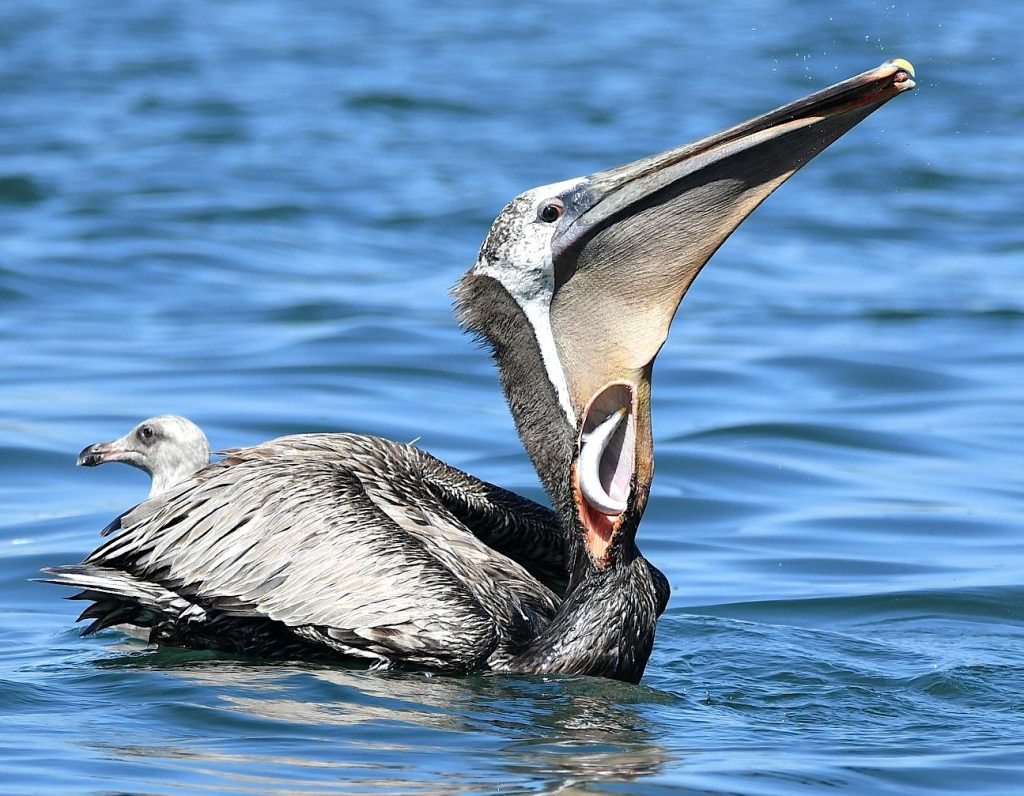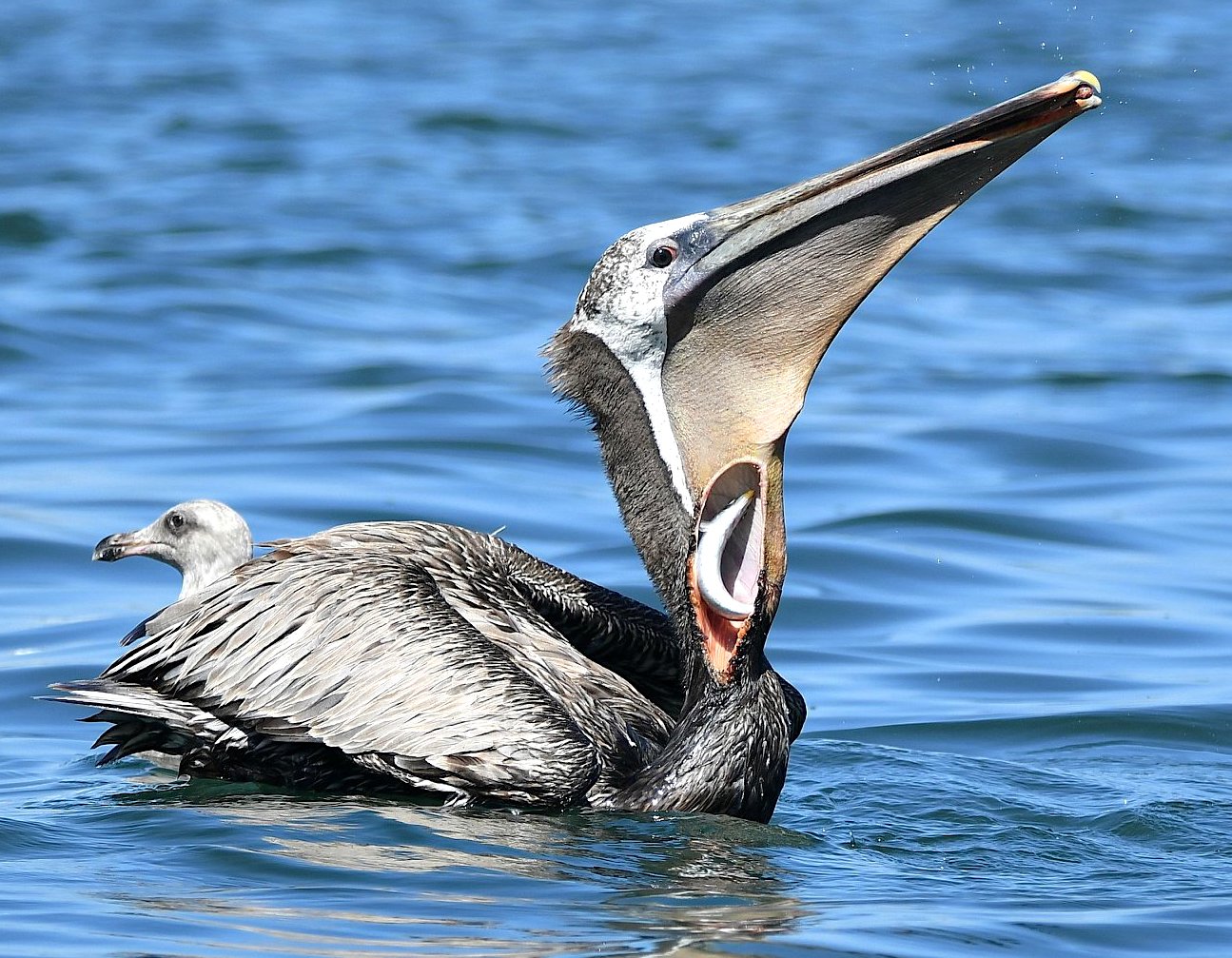Utah, a place where you can encounter both species of Pelican that exist in North America. These fascinating creatures include the American White Pelican and the Brown Pelican. The American White Pelican tends to grace the region during the summer months, while the Brown Pelican is a rare sight, seldom observed in Utah.
Pelicans, renowned for their massive bills, impressive throat pouches, and sturdy feet, rank among the largest avian species globally. Despite their imposing size, they possess a lightness that defies expectation. This quality arises from the air pockets present in their bones and skin, which aid in buoyancy, complemented by their elongated wings that enable graceful soaring while airborne.
Globally, there are a total of eight distinct pelican species, with two of them inhabiting North America. These two species, the American White Pelican and the Brown Pelican, capture attention and admiration.
During the breeding season, pelicans undergo striking changes in their facial skin, throats, and bills, resulting in vibrant colors and even additional growths on their bills.
When it comes to reproduction, pelicans prefer to breed in colonies that can encompass an astounding 50,000 individuals. The nesting preferences vary depending on the species, with some choosing ground-based nests, while others opt for trees. After approximately 25 days in the nest, the young pelicans form groups, known as “creches,” with up to 100 individuals. Remarkably, the parents possess the incredible ability to recognize and exclusively feed their own offspring.
While pelicans indeed prey on other animals, they are not classified as birds of prey, a category reserved for raptors. Their primary diet consists of fish, although they do consume a diverse array of food, including crabs, frogs, snakes, mammals, birds, and insects.
To capture their piscine prey, pelicans utilize their distinctive throat pouches, skillfully scooping fish and subsequently draining the water before swallowing. Young pelicans even feed directly from their parents’ pouches.
For bird enthusiasts seeking to identify the Pelicans present in Utah, this guide draws upon avibase and data collected by dedicated bird watchers on ebird, providing authentic information regarding the sightings of these birds.
Utah is home to two Pelican species:
1. American White Pelican

American White Pelicans can be spotted throughout the year in Utah, with their numbers increasing during migration periods from April to June and August to September. They predominantly inhabit the central and northern regions of the state.
Bird watchers have reported American White Pelicans in approximately 11% of summer checklists, 1% of winter checklists, and up to 15% of checklists during migration in Utah.
As magnificent soaring creatures, American White Pelicans possess the second largest average wingspan among North American birds.
Non-breeding adult American White Pelicans exhibit a pristine white plumage, except for their black flight feathers, which become visible during flight or when the wings are outstretched. These pelicans boast bluish-gray eyes and yellow facial skin surrounding their eyes. Additionally, their bills, pouches, and feet feature a pale orange hue. Juveniles display light gray feathers with darker brown napes.
Breeding adult American White Pelicans display distinct variations in coloration compared to their non-breeding counterparts. They develop a yellow plate on their upper bills, resembling a horn. While their bodies remain entirely white, their eyes, bills, legs, and feet acquire a brighter orange tint.
American White Pelicans undergo molting changes known as eclipse. In spring, a visible yellowish patch emerges on their breast and chest, while in summer, their heads are adorned with blackish feathers.
- Scientific name: Pelecanus erythrorhynchos
- Length: 60 – 63 inches (152 – 160 cm)
- Weight: 246.4 ounces (6983 g)
- Wingspan: 96 – 110 inches (244 – 279 cm)
American White Pelicans breed in secluded inland lakes within North America before embarking on winter sojourns along the southern Pacific Coast of the United States, the Gulf of Mexico, Mexico, and Central America. During migration, they can be observed in various western and central U.S. states.
These pelicans favor shallow freshwater lakes, wetlands, and the peripheries of lakes and rivers. In winter, they can be found in coastal bays, inlets, and estuaries, where they seek nourishment in shallow waters and rest on sandbars.
The primary diet of American White Pelicans comprises fish. They skillfully navigate the water surface, capturing prey with their vast bills. They are also known to engage in cooperative foraging with other birds, strategically herding fish towards the shore to facilitate efficient feeding.
Furthermore, American White Pelicans exhibit opportunistic feeding behaviors, venturing long distances in search of favorable feeding grounds. They may also consume crayfish, amphibians, salamanders, and even pilfer fish from other water-dwelling birds.
As for their vocalizations, American White Pelicans typically remain silent, emitting only occasional grunts. However, the young can be quite vociferous within large colonies as they vocalize their demands for sustenance.
Regarding nesting habits, American White Pelicans construct simple, shallow depressions on the ground. They reinforce these nests with twigs, sticks, reeds, and other materials to provide protection for their eggs.
The female pelican lays one to two eggs, and both parents diligently incubate them together for approximately 36 days. Regrettably, due to a phenomenon known as siblicide, wherein one sibling eliminates the other, only one chick per nest ultimately survives.
Fun Fact: The impressive bill of the American White Pelican possesses the extraordinary capacity to contain up to three gallons of water. When the pelican captures fish from the sea, it tilts its bill downward, allowing the water to drain, leaving behind the fish for consumption within its throat sac.
2. Brown Pelican

While Brown Pelicans are not commonly found in Utah and are considered rare or accidental visitors, there have been a few documented sightings, primarily in the vicinity of Bear River Migratory Bird Refuge.
Non-breeding adult Brown Pelicans exhibit white heads and necks with pale yellow foreheads. Their lengthy bills showcase a combination of yellow and orange hues. Their bodies present a grayish-brown appearance, accompanied by short, black legs and webbed feet. Juveniles display brown heads, necks, backs, and wings, complemented by bluish-gray bills, while their undersides are a light shade of brown.
The Brown Pelican encompasses five subspecies, two of which breed in the United States. The Pacific Coast variant, known as P.o.californicus, and the Atlantic Coast variant, referred to as P.o.carolinensis.
Distinct differences between the Pacific and Atlantic Brown Pelicans become more evident during the breeding season. Both species exhibit white heads with noticeably brighter yellow foreheads. However, the color of their napes transforms from white to dark brown. Atlantic Brown Pelicans possess olive-brown throat pouches, while Pacific Brown Pelicans feature red skin in their throat pouches.
- Scientific name: Pelecanus occidentalis
- Length: 48 – 50 inches (122 – 127 cm)
- Weight: 131.2 ounces (3718 g)
- Wingspan: 78 – 84 inches (198 – 213 cm)
Brown Pelicans either breed and migrate or remain year-round along the Pacific and Atlantic Coasts of North America, extending down to northern South America.
Preferred habitats for Brown Pelicans encompass shallow water environments. They can be found year-round in estuaries and coastal marine habitats. Resting locations include mangrove islets, sandbars, breakwaters, and offshore rocks.
The diving capabilities of Brown Pelicans distinguish them from other species. They possess the unique ability to plunge into the depths of the ocean to capture prey in their expansive throat pouches. Upon resurfacing, the water drains from their pouches, allowing them to promptly consume their catch.
Their primary diet consists of fish, such as sardines and herring. When not engaged in diving behavior, they leisurely swim and seize prey with their bills. Additionally, they may feed on crustaceans like prawns, amphibians, eggs, and other young birds.
As for vocalizations, adult Brown Pelicans generally remain silent, emitting the occasional grunt. However, juveniles tend to squawk in a begging manner to elicit food from their parents.
Nesting habits of Brown Pelicans lean more towards ground-based construction rather than tree nests. They typically seek concealment and protection on islands, within mangroves, or atop cliffs. The female pelican constructs the nest using reeds, leaves, pebbles, sticks, and soil. A typical clutch consists of two to four eggs, which both parents diligently incubate for approximately one month.
Fun Fact: Brown Pelicans have a peculiar incubation technique wherein they cover their eggs using their webbed feet. Unfortunately, during a period when the pesticide DDT led to eggshell thinning, this behavior inadvertently led to egg breakage due to the weight of the parent’s feet. Numerous conservation efforts were required to restore the population of Brown Pelicans.
